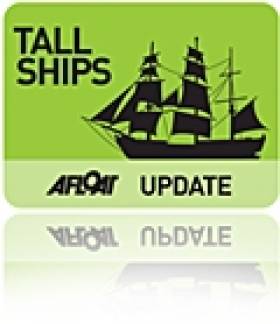Displaying items by tag: Dublin Tall Ships Races Parade of Sail
Dublin’s Tallship Link to Parade of Sails Naval (Guard) Ships
#TALL SHIPS – At the Dublin Tall Ships Races Festival, the docklands-based replica 19th century barque Jeanie Johnston was open to the public, however a former Irish Naval Service vessel, could of been there in her place, had circumstances in the past had taken a different course, writes Jehan Ashmore.
Since 2005, the Jeanie Johnston has been owned by the Dublin Docklands Development Authority (DDDA) which as part of its remit was to regenerate water-borne activity along the Liffey. In May this year it was announced the authority is to be wound-down over a period of 18 months.
The Jeanie Johnston currently serves as a static floating emigrant famine museum. This is a stark contrast to when the barque made a historic re-enactment voyage in 2003 of her predecessor which carried Irish emigrants across the Atlantic, between 1845-1855 to Quebec, Baltimore, and New York.
Prior to the acquisition of Jeanie Johnston by the DDDA, the L.E. Deirdre (P20) was decommissioned four years previously when the Naval Service put her up for auction. She is an elder half-sister of the L.E. Emer (P21) which performed 'guardship' duties during last Sunday's Parade of Sail off Dun Laoghaire Harbour.
Notably the L.E. Deirdre is historically significant in that she was the first custom-built newbuild for the Naval Service and also the first such vessel built in the country, at Verolme Cork Dockyard in 1972, however despite campaigns to keep her as part of our national maritime heritage, this did not materialise, as she was sold at a bargain price of £180,000 to a UK company.
Initially this saw the vessel go to the ship-repair yard of Pomerania, in Szczecin, ironically the Polish city which was the presenting sponsor of the Dublin Tall Ships Races Festival in association with Sail Training International (STI).
However the owner of the former Naval Service vessel, died in 2004, and work on transforming the offshore patrol vessel into a luxury charter yacht, which included installing a helicopter landing pad, came to a standstill. She was sold again and towed to Brazil in 2005 where it is believed the 220ft vessel renamed Santa Rita, painted beige replacing the dull naval grey, was to be completed in 2010.
Yesterday L.E. Emer departed Dublin Port to resume routine patrols and the last large tallship to bid the capital farewell, the A-class, Italian Navy's Amerigo Vespucci, was underway last night. This leaves the Swedish Navy's gaff schooner Falken (class-B) as the last of the tallships still in port.
























































